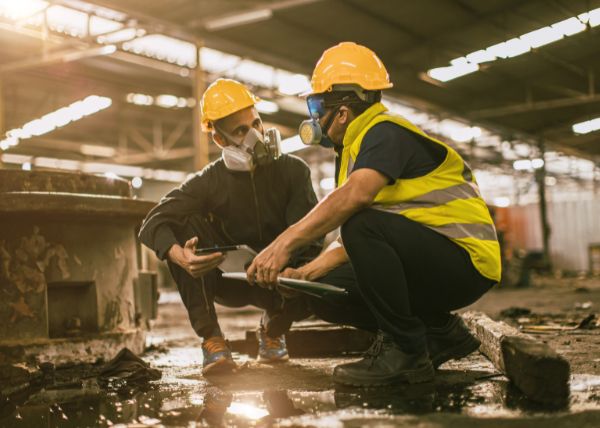At Katz, Leidman, Freund & Herman, we understand that a safe workplace is essential for the well-being of employees and the overall success of a business. However, hazards can still arise, posing significant risks to workers across various industries. In this blog, we will explore the most common workplace hazards, from slips and falls to exposure to harmful substances, and how they can impact your health and safety. If you or a loved one has been injured on the job, don’t hesitate to reach out to our experienced team. Contact us today to discuss your case and ensure you receive the compensation you deserve.
What Is a Workplace Hazard?
A workplace hazard is any condition or situation in a work environment that poses a risk of injury, illness, or harm to employees. These hazards can stem from various sources, including physical, chemical, biological, ergonomic, and psychosocial factors. Understanding these risks is crucial for employers and employees alike, as it enables the implementation of effective safety measures to minimize incidents and ensure a safer work environment.
Certain industries are more prone to workplace hazards due to the nature of their operations. For instance:
- Construction: Often regarded as one of the most hazardous industries, construction sites expose workers to risks such as falls from heights, equipment accidents, and exposure to harmful substances like asbestos or silica dust.
- Manufacturing: In manufacturing settings, workers may face hazards related to machinery operation, such as entanglement, cuts, and hearing loss from excessive noise levels.
- Healthcare: Healthcare professionals encounter various hazards, including exposure to infectious diseases, needle stick injuries, and lifting-related injuries due to patient handling.
- Transportation: The transportation industry involves risks such as vehicle accidents, exposure to hazardous materials, and fatigue-related incidents.
Recognizing and addressing workplace hazards is essential for creating a culture of safety and preventing workplace injuries. If you or someone you know has suffered due to unsafe working conditions, don’t hesitate to contact Katz, Leidman, Freund & Herman. Our dedicated team is here to help you navigate your workers’ compensation claim and ensure you receive the support you need.
Most Common Workplace Hazards
Workplace hazards vary across different industries, but certain risks are prevalent in many work environments. Below are some of the most common hazards that employees face:
Slips, Trips, and Falls
These are some of the most frequently reported workplace accidents. Wet floors, uneven surfaces, cluttered walkways, and inadequate lighting can all contribute to slip, trip, and fall injuries, which often lead to sprains, fractures, or head injuries.
Hazardous Materials
Exposure to harmful chemicals, gases, or substances is common in industries such as manufacturing, construction, and healthcare. Without proper protective equipment and safety procedures, workers can suffer from burns, respiratory issues, or even long-term health conditions.
Repetitive Motion Injuries
Ergonomic hazards arise when workers perform the same motions repeatedly, leading to conditions like carpal tunnel syndrome or tendinitis. These injuries are common in office jobs, manufacturing, and assembly line work.
Heavy Machinery and Equipment Accidents
In industries like construction and manufacturing, operating heavy machinery presents significant dangers. Workers can be injured by falling objects, entanglements, or equipment malfunctions, often leading to serious or fatal injuries.
Fire and Explosions
Fires and explosions may result from flammable materials, faulty electrical systems, or unsafe storage practices. These incidents can cause severe burns, respiratory damage, or even death.
Electrical Hazards
Electric shocks or burns are common hazards in construction, maintenance, and industrial jobs. These can occur due to faulty wiring, damaged electrical equipment, or lack of proper safety procedures.
By recognizing and addressing these common workplace hazards, employers can create a safer environment for their workers. However, if you’ve been injured due to unsafe conditions at work, Katz, Leidman, Freund & Herman is here to help. Our experienced attorneys can guide you through the workers’ compensation process and fight for the compensation you deserve. Contact us today for a free consultation.
How to Prevent Workplace Hazards

Preventing workplace hazards is crucial to ensuring the safety and well-being of employees. Employers and workers must take proactive measures to identify risks and implement safety protocols. Here are some effective strategies to prevent workplace hazards:
1. Conduct Regular Safety Inspections
Routine safety audits and inspections help identify potential hazards before they cause harm. Employers should inspect equipment, workspaces, and procedures to spot risks such as faulty machinery, exposed wiring, or cluttered walkways.
2. Provide Proper Training
Comprehensive safety training is key to preventing accidents. Employees should be well-informed about the hazards specific to their industry, including how to safely operate machinery, handle hazardous materials, and use protective equipment. Regular refresher courses should also be provided.
3. Use Personal Protective Equipment (PPE)
Employers must provide appropriate PPE such as hard hats, gloves, safety goggles, and respirators. Workers should be trained to use PPE correctly and consistently to minimize exposure to hazardous materials, physical injuries, and other risks.
4. Implement Ergonomic Solutions
Prevent repetitive motion injuries by ensuring that workstations and tools are ergonomically designed. Adjustable chairs, proper lifting techniques, and regular breaks can reduce strain on the body and prevent injuries.
5. Maintain a Clean and Organized Workspace
Slips, trips, and falls are often caused by cluttered or poorly maintained work areas. Keeping workspaces clean, removing hazards from walkways, and ensuring proper lighting can help prevent these common accidents.
6. Follow Safety Regulations and Standards
Adhering to OSHA (Occupational Safety and Health Administration) regulations and industry-specific safety standards is essential for minimizing workplace hazards. Employers should stay updated on the latest guidelines and ensure that their safety practices are compliant.
7. Encourage Open Communication
Workers should feel comfortable reporting safety concerns or potential hazards without fear of retaliation. Open communication between employees and management promotes a culture of safety, allowing issues to be addressed promptly.
By taking these preventive measures, employers can create a safer work environment and reduce the risk of accidents and injuries. If you’ve been injured at work due to unsafe conditions, contact Katz, Leidman, Freund & Herman for a free consultation. We are committed to helping injured workers obtain the compensation they deserve.
What To Do After a Work Injury
Experiencing a work-related injury can be overwhelming, but taking the right steps afterward is crucial for protecting your health, your rights, and your ability to secure workers’ compensation benefits. If you’ve been injured at work, follow these steps to ensure you get the care and support you need:
- Seek Immediate Medical Attention: Your health should always be the top priority. Whether it’s a minor injury or a severe accident, seek medical treatment as soon as possible. Even if your injury seems manageable, underlying issues could worsen over time without proper care. Be sure to inform the healthcare provider that the injury is work-related, so they can document it appropriately.
- Report the Injury to Your Employer: Notify your employer about the injury as soon as possible. In New York, there are specific deadlines for reporting workplace injuries. Failing to inform your employer within the required time frame could jeopardize your workers’ compensation claim. Make sure to provide details about when, where, and how the injury occurred.
- Document Everything: Keep detailed records of the injury, your medical treatments, and any conversations you have with your employer or insurance company. Take photos of the injury if applicable, gather witness statements, and keep copies of all medical reports, bills, and receipts related to the injury.
- File a Workers’ Compensation Claim: After reporting your injury, your employer should provide you with the necessary forms to file a workers’ compensation claim. In New York, you generally have two years from the date of the injury to file your claim, but starting the process sooner is always recommended. This claim will help you secure benefits for medical bills, lost wages, and rehabilitation.
- Consult a Workers’ Compensation Attorney: Navigating the workers’ compensation process can be complex, especially if your claim is denied or disputed. Consulting with an experienced workers’ compensation attorney can help ensure your rights are protected and that you receive the maximum benefits you deserve.
At Katz, Leidman, Freund & Herman, we understand the challenges injured workers face, and we are here to guide you through every step of the process. If you’ve been hurt on the job, don’t navigate the legal complexities alone. Contact our firm today for a free consultation, and let us help you secure the compensation you deserve.
Contact Katz, Leidman, Freund & Herman Today
If you’ve been injured at work, don’t face the challenges of a workers’ compensation claim alone. The legal team at Katz, Leidman, Freund & Herman has decades of experience helping injured workers secure the benefits they deserve. Whether you need assistance filing a claim or are facing a denial, we are here to fight for your rights. Contact us today for a free consultation and take the first step toward protecting your future.

